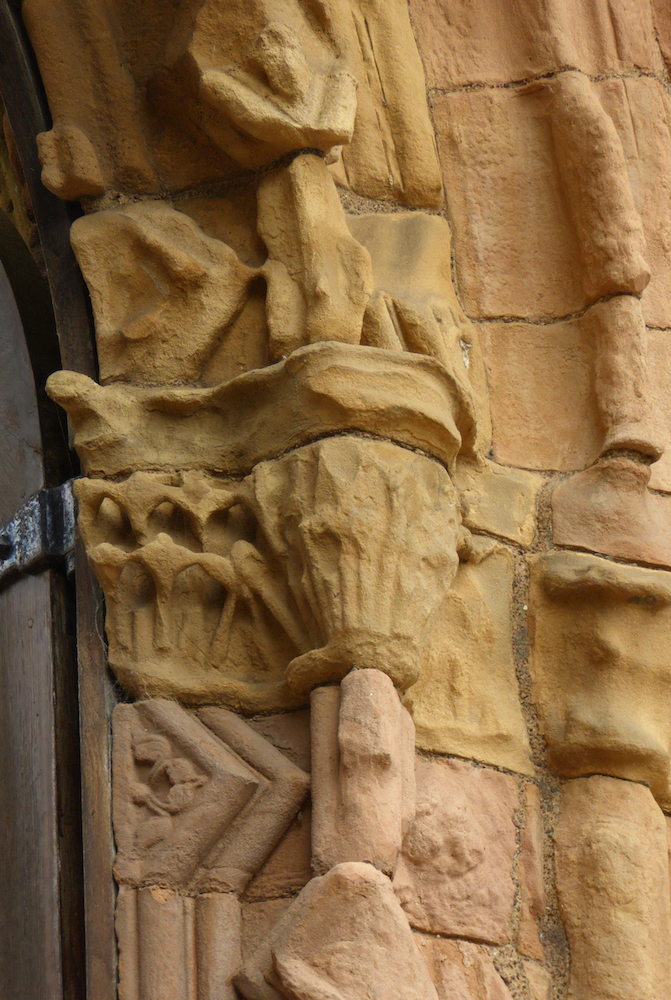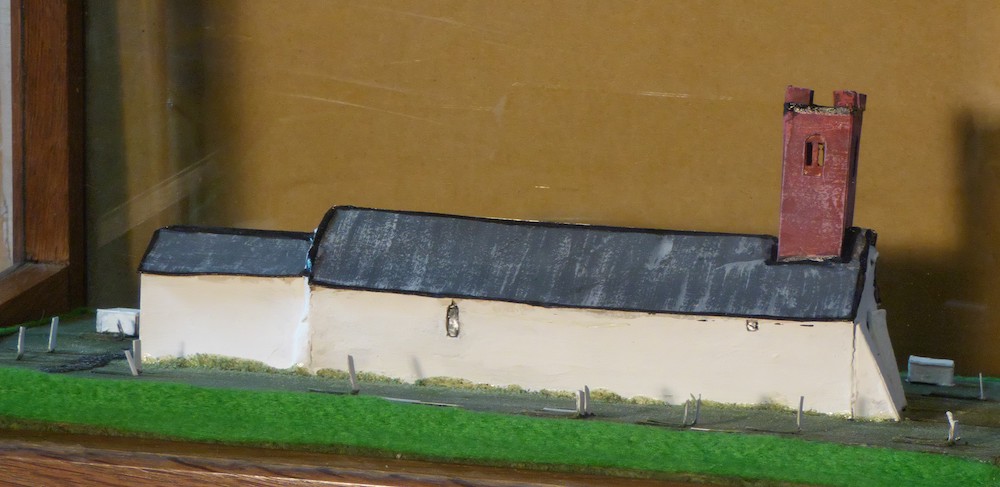Individual Examples of Restoration
1. Chantrell in Yorkshire

Fangfoss, reset vesica and carved Trinity.
Robert Dennis Chantrell was an architect who was not prejudiced against the Romanesque, and was years ahead of the public in the interest he took in the archaeology of buildings (Webster, Leeds, 107). In 1848-50 he worked on a restoration at Fangfoss in the East Riding of Yorkshire with a sympathetic incumbent (Wood-Rees 254; Webster, Lost Generation). Together, Chantrell and the Rev. Robert Taylor unearthed "much beautiful material in a perfect state," and found evidence for an apsidal east end with three windows, also the base of a Norman west tower; these traces were measured but not rebuilt. They found mouldings in the shape of a "vesica piscis" which excited Chantrell because he was one of those who hoped to find evidence of the guiding principles of "ancient architecture," and this shape was held to be a starting point for a study of medieval proportional systems (Webster, Leeds, 109-119, especially 111). The vesica survives reset inside the church, together with what had possibly been the boss of the vaulted apse; this has a crudely-made but theologically-adequate representation of the Trinity which would nowadays be considered a more significant object than the vesica.


Left: Fangfoss, Chantrell's interior (1848-50). Right: Fangfoss, left side of south doorway.
Despite all the excitement over the finds, the new interior at Fangfoss could not be plainer: the profiles of the round-headed chancel arch are plain and square, and the east end is straight. Much of the "perfect" sculpture from the "two highly ornamented arches" of the chancel and apse, was repositioned outside as a south doorway to the nave, where it has decayed fast since 1850. One can only be glad that the restoration retained at least enough of the corbels to populate the south side of the church, along with samples of the varied string-courses and the window-heads; further sculptured stonework was kept for a time, but is now lost except for a few voussoirs in the Hull and East Riding Museum.


Left: Malton, St Michael, Chantrell’s chancel (1858). Right: Malton, north side of chancel arch.
At Adel, near Leeds, in 1838-9 Chantrell provided an over-sized bell-cote at the west end, and may have replaced some of the north side corbels with exaggerated forms; in 1843, he restored the chancel roof to its original height (Webster, Leeds, 70, 107-8; Draper 158, 161-2). At Shadwell, Leeds, in 1840-42 he designed and built a small new church reminiscent of Adel (Webster, Leeds, 108; pl. 20). In Malton in 1858, his new east end to St Michael’s, the church on the market-place (Pevsner 234), has a plausible east fenestration of three round-headed windows and an oculus. The new chancel arch fits well with the old nave arcades but Chantrell overdeveloped the pattern on its label. and used beakheads as if they were label-stops — which they are not, at least in Yorkshire. Although this architect was interested in using the Romanesque style, he had the Victorian penchant for exaggeration and eclecticism.
2. Pearson in Yorkshire


Left: Riccall, nave doorway propped up (c. 1864). Right: Riccall, the doorway during building work.
John Loughborough Pearson had grown up familiar with Durham cathedral, and entered an architect’s office in that city. His master, Bonomi, was "unusually aware of medieval work" (Pevsner and Williamson 47) and Pearson kept his affection for the Romanesque style even though he made his living, and later fame, out of the favoured Gothic (Quiney 5, 10). During the rebuilding at Riccall (1861-77), he discovered foundations of an apse in what is now the eastern bay of the nave. As can be seen above, he did not disturb the twelfth-century doorway though much of the rest of the nave had to come down. This lack of interference was deliberate and cautious, but meant that no damp course was inserted at this point, thus contributing to modern problems with ground water rising up towards the sculpture. Pearson’s restorations of early twelfth-century churches in the Wolds for the first Sir Tatton Sykes are notably sympathetic and restrained (Wood, “Kirkburn”; “Bishop Wilton”). Perhaps his steady fondness for the wrong style was a factor in his being dropped by the second Sir Tatton in favour of George Edmund Street.
3. G. F. Watts at Jedburgh


Left: Jedburgh abbey, late 12th-century doorway. Right: Jedburgh abbey, late 19th-century doorway.
Jedburgh Abbey, an Augustinian site, is the grandest survival of the early twelfth-century foundations of King David I; the nave of the church is largely of the late twelfth century. Parts of the building continued to be used by the parish until 1875, when a modern church was built on a new site and the ruins were restored to their medieval form by Schomberg, ninth Marquis of Lothian. There are two doorways linking the cloister to the nave, of which the south-east is original, and the other "a facsimile" of it by "Watts of Farmer and Brindley c.1875 under the direction of R. Rowand [sic] Anderson" (Watson 18, 176; Cruft et al. 406, 415). The artist and sculptor G. F. Watts had had William, the late eighth Marquis, as friend and patron, and about this time he was working on the memorial to his friend which is at Blickling church in Norfolk, and a reduced version for the Lothian burial place in the north transept of Jedburgh abbey. The late Romanesque remains of the abbey church received praise at the time: Sir Gilbert Scott said the western doorway and the one on the cloister were "two of the most exquisite gems of architectural art in this island"; James Watson wrote that "the cloister doorway possesses features of interest of no ordinary kind," with a "chasteness of design and a delicacy of execution altogether unique." Perhaps such praise was allowable because of the Transitional nature of the work, edging towards early Gothic (see Garton).



Three views of the doorways at Jedburgh Abbey: (a) A "touch of romanticism" in the new voussoir compared to.... (b) The same area in the old doorway. (c) The capitals of old doorway.
The south-west doorway, the facsimile, was not necessary to the rebuilding of the abbey church and does not seem to have replaced an original doorway in that position. It was an act of restoration as we might understand it: "[the south-east] doorway having become very much decayed, the present Marquess of Lothian, the noble proprietor of the abbey, ordered a facsimile of this beautiful piece of architectural art to be made so that a faithful copy might be preserved" (Watson 18). Watt’s doorway has a complete arch of individual subjects in the third order, whereas the old doorway presently retains few even partially-legible subjects there; it is possible that, 140 years ago, reasonable copies could still have been made, yet the usual touch of creative romanticism crept in, perhaps where decay was too advanced, or due to lack of knowledge of comparisons (Garton, pl. 23). Also, it would have been normal in the twelfth century for the capitals on the old doorway to have varied from order to order in the form of their foliage (Garton, pl. 46), but on the new doorway the capitals are identical, and their number seems to have increased from eight to ten. This rare attempt at a copy is, nevertheless, increasingly valuable.
4. J. R. Lunn at Marton


Left: Marton-cum-Grafton, model by the Rev. J. R. Lunn showing south side of the old church. The figure in the porch was added in a recent restoration of the model. Right: Model showing north side of the old church.
In the early 1870s, the antiquarian vicar of Marton-cum-Grafton in Yorkshire, the Rev. John Robert Lunn, made a plan, drawings and a model of the old village church at Marton; without all these we would have had no idea what a very humble building it was. He then had the church taken down and built a new one on a site nearer the village (see Lunn). He watched closely over the progress of demolition, picking out interesting carved pieces to be reused, and he searched for the quarries which could match his finds and serve his ambition: Lunn’s methods were, on a small, amateur scale, what Pearson had used in restoring the chancel at Stow-in-Lindsey (Lincs) in the 1850s (Quiney 42).

Marton-cum-Grafton, the invented doorway made of old and new stones (1870s).
Lunn’s triumph was a doorway of four orders, placed, not at the entrance to the nave, but in the south wall of the chancel, leading into the vestry. The size of the arch is dependent on the curvature of four or five chevron voussoirs, and this indicates they came from a doorway, not the chancel arch as he supposed. At a rough estimate, about 20% of the doorway is reused old stones, with the shortfall made up by repeats and exemplars from other sites: bases were copied "but not servilely" from some at Burford (Oxon), shafts from Windrush (Gloucs) and some capitals from Canterbury. The doorway displays relevant treasures in an orderly manner, while odd carved stones that had no obvious function were reset inside the vestry in amusing and useful ways. Lunn is an interesting character at a time of transition from carelessness about old buildings to scientific enquiry into them.
5. Robert Willis (1800-1875)
Despite the occasional favourable view taken of Romanesque buildings, some examples of which are sketched above, "the major contribution of the Victorian age to Romanesque studies was in the academic field. The researches of scholars like Willis made the dating of the style and of its evolution much more precise..." (Cooke 364). Beginning with a paper on Hereford cathedral in 1842, and continuing to Worcester in 1863, Willis analysed, planned and dissected eight English cathedrals (see Willis). The Rev. Robert Willis was not an architect, but professor of Mechanics at Cambridge, and if there were scholars "like" Willis, they tend to appear later in the century, for example, William St. John Hope (1854-1919), and John Bilson (1856-1943). For the recording and appreciation of the past which was going on more generally in the nineteenth century, the reader is recommended to detailed surveys in Cooke, and Rodwell 18-21.
Created 15 January 2019